 Snoods are a very popular item at renaissance fairs. Most of them are
crocheted; some are beaded. Some tie off with a string, while others have
elastic in the band to keep the snood on ones head.
Snoods are a very popular item at renaissance fairs. Most of them are
crocheted; some are beaded. Some tie off with a string, while others have
elastic in the band to keep the snood on ones head.
 Snoods are a very popular item at renaissance fairs. Most of them are
crocheted; some are beaded. Some tie off with a string, while others have
elastic in the band to keep the snood on ones head.
Snoods are a very popular item at renaissance fairs. Most of them are
crocheted; some are beaded. Some tie off with a string, while others have
elastic in the band to keep the snood on ones head.
Snoods are convenient. They keep your hair out of your face and off of your neck, and are especially useful if you don't have the time--or the hair--to put it in a bun, braids, or other period looks. I've worn them myself--they're practical and useful items of headwear, especially if you're very busy or active.
Unfortunately, the snoods you usually see sold at renaissance faires aren't themselves authentic. Crochet wasn't invented until the 17th century. In period, hairnets were made by knotting thread or cord together, rather like fishing nets; and the thread or cord was much finer than the crocheted netting in modern snoods. The drawing to the left is a picture of what a period "snood", known as a caul, looked like.
So what about snoods during the Tudor and Elizabethan Eras?
 Although there aren't many images of Hairnets and bag hairdresses before 1550, there are some to be found. One such is a drawing by Hans Holbein which shows a young girl wearing a charming, "snood"-type headdress with a wired front, which is shown to the right.
Although there aren't many images of Hairnets and bag hairdresses before 1550, there are some to be found. One such is a drawing by Hans Holbein which shows a young girl wearing a charming, "snood"-type headdress with a wired front, which is shown to the right.
This bag-coif has a silhouette similar to the wired coif of the time, but has a gathered bag at the back covering the girl's head.
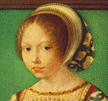 Another picture, again of a young girl, shows her wearing a similar bag-like headdress--this time behind a french hood. Although rarely seen in period portraits, this was worn on occasion--usually by small girls and young women. The fabric of the bag could match the dress, as does the bag to the left.
Another picture, again of a young girl, shows her wearing a similar bag-like headdress--this time behind a french hood. Although rarely seen in period portraits, this was worn on occasion--usually by small girls and young women. The fabric of the bag could match the dress, as does the bag to the left.
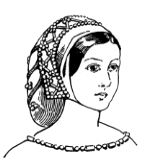 Other examples of this headdress show a bag of black velvet or silk covered with gold netting. The drawing to the right is taken from a portrait of Katherine, daughter of Francis I, painted in 1527. The bag and the hood are both of gold tissue, banded and embroidered with pearls and passamayne. A tassle of gold was sometimes fixed to the end of this bag, according to Herbert Norris.
Other examples of this headdress show a bag of black velvet or silk covered with gold netting. The drawing to the right is taken from a portrait of Katherine, daughter of Francis I, painted in 1527. The bag and the hood are both of gold tissue, banded and embroidered with pearls and passamayne. A tassle of gold was sometimes fixed to the end of this bag, according to Herbert Norris.
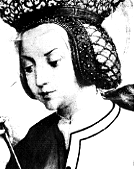 In Tudor Spain, the gathered bag--known as a cofia, redecilla (little net), albenaga, or garvin--could be made of fine linen, silk, or netting. Some of these headcoverings allowed the hair to hang free beneath, while others, such as the painting of a princess shown to the left (c. 1525) contained the hair beneath like a modern snood.
In Tudor Spain, the gathered bag--known as a cofia, redecilla (little net), albenaga, or garvin--could be made of fine linen, silk, or netting. Some of these headcoverings allowed the hair to hang free beneath, while others, such as the painting of a princess shown to the left (c. 1525) contained the hair beneath like a modern snood.
In Italy, a fashionable early 16th century headdress known as the balzo was similar to a snood; it was a large gathered bag, often made of woven strips of fabric, fancy gold material and lace, or other materials, worn over the hair. From the front it could look more like a roll worn over the hair, as the greater portion of its bulk was above the head.
 Finally, to the right is a portrait of Martin Luther's wife, painted in 1529, showing her wearing a finely netted hairnet without any fabric beneath it. This net would be made of silk cord, if worn by a well-to-do lady, and could have been worn in conjuction with a veil or other form of headwear, such as the broad flat hat popular in Germany at the time.
Finally, to the right is a portrait of Martin Luther's wife, painted in 1529, showing her wearing a finely netted hairnet without any fabric beneath it. This net would be made of silk cord, if worn by a well-to-do lady, and could have been worn in conjuction with a veil or other form of headwear, such as the broad flat hat popular in Germany at the time.

|
They have also other ornaments besydes these to furnish foorth their ingenious heads, which they cal cawles, made Netwyse, to th' ende, as I thinke, that the clothe of gold, cloth of silver, or else tinsell (for that is the worst) wherwith their heads are covered and attyred withall underneath their cawles maye appeare, and shewe it selfe in the bravest maner. So that a man that seethe them would thinke them to have golden heads."
|
The Elizabethan gentlewoman didn't wear a snood per se. She did wear something similar, which was called a "caul". A caul was a small bag pinned over the bun and hair at the back of the head, like the woman to the left is wearing. It wasn't as big as the modern "snood"--it didn't hang down the back of the neck--and was frequently worn with other headwear, including tall hats, flat caps, "billiments", and even over coifs.
 In period portraits, cauls were made of fabric, or fabric covered by netted
cord. There are references in Queen Elizabeth's wardrobe accounts to cauls made of wire, braided hair, and "cheine lace", a possible reference to a precursor of crochet. Cauls were also frequently decorated with applied cord, couched
or embroidered on, as well as pearls, gems, and other expensive
decoration for the nobility. The woman to the right is wearing a caul covered with a netting of metallic thread and pearls. A hairnet, or "snood"
with a layer of fabric underneath would make a splendid and period-looking
caul to wear alone or with the headwear of your choice.
In period portraits, cauls were made of fabric, or fabric covered by netted
cord. There are references in Queen Elizabeth's wardrobe accounts to cauls made of wire, braided hair, and "cheine lace", a possible reference to a precursor of crochet. Cauls were also frequently decorated with applied cord, couched
or embroidered on, as well as pearls, gems, and other expensive
decoration for the nobility. The woman to the right is wearing a caul covered with a netting of metallic thread and pearls. A hairnet, or "snood"
with a layer of fabric underneath would make a splendid and period-looking
caul to wear alone or with the headwear of your choice.
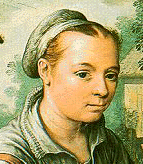 Another "snood"-like headdress worn during Elizabethan times was called the "italian coif". It was worn in Flanders during the 1570s, which is when this picture to the left was painted; it is, quite simply, a circle of fabric gathered to a band, similar to a caul in every respect save the size of the gathered circle, which is slightly bigger than a caul would be. It could be white linen, as this coif is, or could be black wool or silk fabric decorated similarly to a caul, seen in some portraits of more affluent flemish women. If the gathered circle of fabric was slightly bigger and the band farther forward on the head, it would be what modern Elizabethan re-enactors term a "muffin cap".
Another "snood"-like headdress worn during Elizabethan times was called the "italian coif". It was worn in Flanders during the 1570s, which is when this picture to the left was painted; it is, quite simply, a circle of fabric gathered to a band, similar to a caul in every respect save the size of the gathered circle, which is slightly bigger than a caul would be. It could be white linen, as this coif is, or could be black wool or silk fabric decorated similarly to a caul, seen in some portraits of more affluent flemish women. If the gathered circle of fabric was slightly bigger and the band farther forward on the head, it would be what modern Elizabethan re-enactors term a "muffin cap".
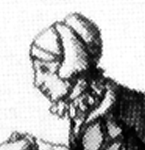 The London washerwoman shown to the right, sketched in 1570, is wearing a gathered caul similar to the Flemish lass to the left. Instead of gathering to a band, however, it is attached to a wired coif. As you can see, there are many variations on a caul or muffin cap that were worn during Elizabethan times.
The London washerwoman shown to the right, sketched in 1570, is wearing a gathered caul similar to the Flemish lass to the left. Instead of gathering to a band, however, it is attached to a wired coif. As you can see, there are many variations on a caul or muffin cap that were worn during Elizabethan times.
If you want to try your hand at making an authentic hairnet to incorporate into your caul, check out this wonderful page on Constructing a Medieval Hairnet.
Constructing an Elizabethan Caul & Muffin Cap